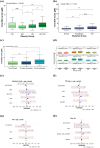Prediabetes and type 2 diabetes but not obesity are associated with alterations in bile acid related gut microbe-microbe and gut microbe-host community metabolism
- PMID: 40045464
- PMCID: PMC11901388
- DOI: 10.1080/19490976.2025.2474143
Prediabetes and type 2 diabetes but not obesity are associated with alterations in bile acid related gut microbe-microbe and gut microbe-host community metabolism
Abstract
The interplay between bile acids (BAs) and metabolic diseases has gained importance in recent years, with a variety of studies investigating their relationship with diverging results. Therefore, in the present study we performed a detailed analysis of BA metabolism in 492 subjects with different metabolic phenotypes. Besides microbiomics and metabolomics this investigation included in silico analysis of community metabolism to examine metabolic interchange between different microbes as well as microbes and the human host. Our findings revealed distinct changes in the BA profiles of patients with diabetes and prediabetes, whereas obesity alone had no influence on circulating BAs. Impaired glycemic control led to increased circulating BAs, a shift toward more secondary BAs, and an increase in the ratio of glycine to taurine-conjugated BAs. Additional analyses revealed that the ratio of glycine to taurine conjugation demonstrated variations between the single BAs, cholic acid (CA), chenodeoxycholic acid (CDCA) and deoxycholic acid (DCA), regardless of the metabolic status, with CA having a higher fraction of taurine conjugation. Furthermore, we found that microbiome alterations are associated with BAs, independent of diabetes or obesity. Analysis of microbial community metabolism revealed differential relative pathway abundance in relation to diabetes, particularly those related to membrane and polyamine synthesis. Increased bacterial cross-feeding of polyamines, galactose, and D-arabinose also coincided with an increase in BA. Notably, our serum metabolome analysis mirrored several of the previously in silico predicted exchanged metabolites, especially amino acid metabolism. Therefore, targeting BA metabolism may be a future approach for the treatment of metabolic diseases, especially prediabetes and type 2 diabetes.
Keywords: Bile acids; gut community metabolism; gut microbiome; type 2 diabetes.
Conflict of interest statement
No potential conflict of interest was reported by the author(s).
Figures







References
MeSH terms
Substances
LinkOut - more resources
Full Text Sources
Medical
